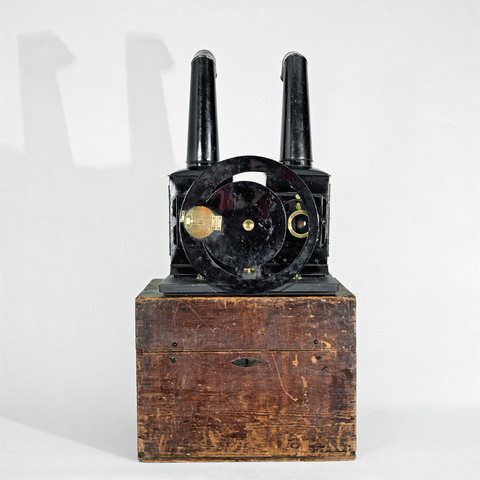Deux lanternes de projection
Fiche détaillée
Type de l'appareil
deux lanternes de projection, montées côte à côte sur un socle en bois noirci ; deux cheminées coudées ; deux objectifs réglables ; passes-vues avec presseur métallique ; une porte sur le côté de chaque lanterne ; réflecteurs interieurs ; molettes pour fixer les lanternes sur le socle ; obturateur métallique en disque, rotatif, avec ouverture en demi-lune pour réaliser les dissolving-views ; fenêtre ronde en cuivre et avec loquet, disposée sur l'obturateur, si l'on veut utiliser les deux lanternes en même temps ; axe de l'obturateur est monté sur un arbre en bois, relié à une manivelle et au socle, le tout pouvant avancer et reculer
Auteurs
Informations non disponibles
Fabricants
Philip Carpenter
Londres, 24 Regent Street, Waterloo Place
William Westley
Londres, 24 Regent Street, Waterloo Place
Utilisateurs
Informations non disponibles
Distributeurs
Informations non disponibles
Sujet du modèle
Informations non disponibles
Objectif
deux condensateurs 8,5 cm de diamètre ; deux objectifs 5 cm de diamètre
Taille de l'objet
Ouvert :
Longueur : 50.5 cm
Largeur : 45 cm
Hauteur : 66 cm
Fermé :
Longueur : 50.5 cm
Largeur : 45 cm
Hauteur : 66 cm
Diamètre :
Informations non disponibles
Taille de la boîte de transport
Longueur : 49.5 cm
Largeur : 55 cm
Hauteur : 42 cm
Remarques
Marques sur la face avant des lanternes : "Carpenter & Westley, 24 Regent Street, London".
Quatre étiquettes en papier à l'intérieur de la boîte en sapin : "General Instructions for using Carpenter & Westley's Phantasmagoria Lantern" ; "Carpenter and Westley, Opticians, 24 Regent Street, Waterloo Place, London SW" ; "The New Material for Carpenter & Westley's Argand Lamp" ; "List of Moveable Astronomical Diagrams, The Motion Produced by Rack-Work".
"To exhibit the Dissolving Views, two lanterns of equal size, and placed on the same platform, are necessary. In the one we will suppose the summer scene ; in the other, the same scene, but in its winter dress. Now, immediately in front of the brass tubes of both lanterns is a circular disk of japanned tin, in which a crescentic slit is perforated half round near the rim. This disk is made to revolve on an axis which passes between the two lanterns, and is moved by a little handle behind. The rays of light proceed through the slit on to the screen, but only allow those of one lantern to do so at one time, the tube of the other being shaded by the imperforate part of the disk. (...) To produce the falling of the snow, a slider is introduced upon the previously blinded side, a cap is unscrewed off the disk, and so both tubes shed their light on the screen" (Chamber's Edinburgh Journal, 28 avril 1849).
"Philip Carpenter was perhaps the most important person in the history of the magic lantern during the 19th century [...]. He was born at Kidderminster on 18 November, 1776, the son of George and Mary Carpenter. In 1815 he is listed in the trade directories as an optician, with a house and manufactory in Bath Row, Birmingham. Later, he also had a retail shop at 111 New Street. His first claim to fame is as the manufacturer of David Brewster's Kaleidoscope in 1819. [...] It was whilst in Birmingham that he also designed a new and more practical form of magic lantern which he proceeded to supply with a series of slides made by a new copper-plate process, which ensured a greater accuracy in the delineation of the pictures and provided the means for producing them in large quantities. He was thus instrumental in raising the status of the magic lantern from a mere optical novelty or toy, to that of a scientific instrument which could be used for educational instruction as well as amusement. The availability of a pratical projector with a regular supply of superior slides also opened the way for the boom in lantern projection which took place in the last half of the 19th century. [...] With the introduction of the new Phantasmagoria Lantern in about 1821, Carpenter issued the first of his slides made by the new process. These consisted of a set of 18 slides on natural history, as well as some others for which we have no particulars. [...] The success accorded Carpenter's Phantasmagoria Lantern and Copper-plate Sliders must have been the determining factor that induced him to leave Birmingham for London. In July 1826 he removed to 24 Regent Street, on the corner of Jermyn Street. In the meantime, the Birmingham business in New Street was continued till 1837, when it was transferred to a Mr. R. Field. Philip Carpenter died at Regent Street on 30 April, 1833, but the business was continued by his sister Mary, in partnership with William Westley. Mary too was a remarkable person and carried on the business for a number of years" (John Barnes, " Philip Carpenter 1776-1833", The New Magic Lantern Journal, Vol.3, n° 2, décembre 1984, p. 8-9).
Bibliographie
"Phantasmagoriae", par Herman Bollaert, The New Magic Lantern Journal, vol. 2, n° 3, janvier 1983.
"Philip Carpenter 1776-1833", par John Barnes, The New Magic Lantern Journal, vol. 3, n° 2, décembre 1984.
